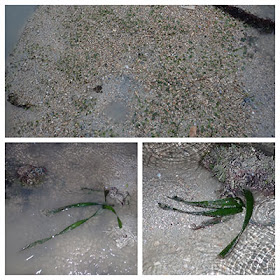Today, I estimate about 10% of the hard corals and 10% of the leathery soft corals that I saw are bleaching, with an additional 10% of each showing stress (paler than usual). A more cheerful moment was coming across a large Fluted giant clam!
I saw several hard corals and leathery soft corals with recently dead portions - a greyish sludge of rotting tissue. The situation is not as bad as what I saw here in 2016.
Some corals were pink, a sign of stress. More about mass coral bleaching here.
Here's a compilation of some of the hard corals I saw, with a ruler for further study by others.
Many of the Asparagus soft corals were very pale, though I didn't see any that were bleaching. I saw zoanthids with sprinkles and patches of bleaching, but most were alright. Other cnidarians such as corallimorphs and Magnificent anemones were alright. I saw one Leathery sea fan which was only alive at the tips.
It was a treat to come across this very large Fluted giant clam. I only noticed it despite the rain because it was regularly squirting out jets of water! Giant clams can also suffer from bleaching, so it was good to see that this one seemed alright.
Isn't it amazing to have such marine life next to our landfill? The seawall is where the landfill is.
There has never been much seagrass on this shore. I saw sprinkles of Spoon seagrass (tiny leaf blades) on the sandy high shore. Here and there among the corals, there were cropped clumps of Tape seagrass.
The light drizzle turns into a steady rain throughout the survey. We left early as lightning started all around us. Sadly, on the way back, we noticed a large fish trap on Terumbu Semakau. We won't be visiting the shore until a few more weeks. Will remove it when we do.
More about Pulau Semakau
Just as Changi Airport and Changi Beach are not the same even though they are near one another and share a name, Pulau Semakau is NOT the same as the Semakau Landfill. The Landfill was created by destroying all of Pulau Saking, and about half of the original Pulau Semakau by building a very long seawall. Fortunately, the landfill was constructed and is managed in such a way that the original mangroves, seagrass meadows and reefs on Pulau Semakau were allowed to remain.

As the existing half of the Landfill was used up, the Phase 2 of the Landfill was launched. This involved closing the gap of the seawall on the Semakau Landfill, forming one big pool where incinerated ash will be dumped. NEA worked to limit the damage to natural shoresduring the construction work for this expansion of the landfill.
The 2030 Landuse Plan by the Ministry of National Development released in Jan 2013 shows plans for 'possible future reclamation' (in light blue surrounded by dotted lines) that may impact the eastern shore of Pulau Semakau. More about the possible impact of the 2030 Landuse Plan on our shores.
Let's hope these shores will be spared this fate.
The Singapore Blue Plan 2018
Pulau Semakau and nearby islands and submerged reefs have been recommended by the Singapore Blue Plan 2018 for Immediate Conservation Priority.
The Blue Plan recommends the intertidal and subtidal marine areas of Pulau Semakau and adjacent Pulau Hantu, and Pulau Jong to be designated Marine Reserve.
The Blue Plan highlights that Pulau Semakau and its associated patch reefs comprise many ecosystems: coral reefs, mangrove areas, intertidal sandflats, seagrass meadows, and coral reefs. The subtidal area of Pulau Jong is larger than the terrestrial area. Pulau Hantu is a popular dive site has seen increasing interest in the past decade due to biodiversity awareness. If protection is accorded to these three islands, zonation plans for use can be implemented to manage tourism and human impacts.
DOWNLOAD the Plan, SUPPORT the Plan! More on the Singapore Blue Plan 2018 site.
Posts by others on this trip












